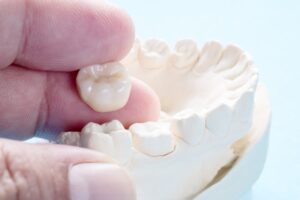
As you sit in the chair being examined by the dentist, they tell you that they see a cavity in one of your teeth. Perhaps without fully knowing exactly what a filling or dental crown is, you know that you could need one of these two restorations, but which is it?
In this post, you’ll learn what makes these restorations unique and when each is most commonly used so that you can feel confident about your treatment.
What’s the Difference Between a Dental Crown and Filling?
Although fillings and dental crowns are both common restorations for tooth decay, they are fundamentally different in a few ways:
- While tooth-colored fillings are made of composite resin (fine ceramic particles and plastic), dental crowns are mostly made of porcelain. Some may consist of metal fused to porcelain for more durability.
- A filling compensates for a small area, and a dental crown surrounds the entire tooth.
- Fillings are placed in one appointment, and dental crowns usually require two visits to complete.
When Is a Filling Appropriate?
A filling is used to replace tooth structure removed from a small cavity. Usually confined to the surface of the tooth, the cavity leaves just a little bit of a hole in the tooth, and fillings, as the name suggests, fills in or substitutes for this lost enamel.
When Is a Dental Crown Necessary?
For cavities or damage that expand beyond a little area, over the cusp of the tooth, or deeper into the tooth, a dental crown is more suitable as a restoration. Because it covers the entire tooth, it can compensate for greater injury or decay and provide the support the tooth needs to still function and appear realistic.
If the tooth is badly damaged or decayed, root canal treatment may be needed. In this case, most of the time, a crown is used to restore the tooth following this therapy because the tooth often needs more structural support.
How Will You Know Which One You Need?
Most of the time, your dentist will tell you which restoration you need for your situation. They may show you an image of your tooth using an intraoral camera or display your X-ray and point out the extent of the decay or damage. From this information, they will recommend the treatment that can make the tooth whole again.
Regardless of which restoration you need, your dentist can bring back your tooth’s form and function and will help you have a smile you can be proud of after your cavity.
About the Author
Dr. Kevin Labosky has been practicing for more than 25 years and opened his own practice in 2004 in State College. He belongs to several professional organizations including the Pennsylvania Dental Association, the OKU Honorary Dental Society, and the Dawson Academy. If you are due for a dental appointment or have a decayed or damaged tooth, you can schedule an appointment with Dr. Labosky at his practice by contacting the team online or calling 814-237-7004.



